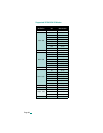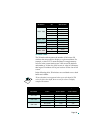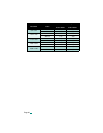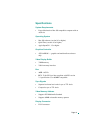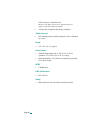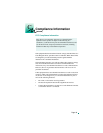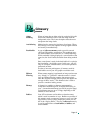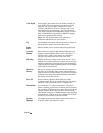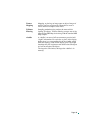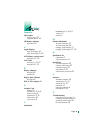
Page 47
Glossary
Alpha
blending
When an image has an alpha value for each pixel, this tells
how much to blend the colors from the image with the
background colors. The lower the alpha values the more
transparent the image looks.
Anti-aliasing
Method used to remove the jagginess of an image. When
anti-aliasing is used, the edges of an image appear smooth
and usually somewhat blurry.
Back buffer
Atypeof
offscreen memory
used to provide smooth
video and 2D graphics acceleration. This technique uses
two frame buffers, often referred to as "double-buffering".
While one buffer is being displayed, a second buffer of the
same size, the "back" buffer, holds the frame being worked
on.
Once a new frame is ready in the back buffer it is copied to
the front buffer - the display screen. In this way, you will
only see complete, smooth frames, and not the operations
performed on them.
In order to increase performance, all memory used for
back buffers are on your ATI graphic accelerator card.
Bilinear
Filtering
When texture mapping is performed an image can become
very “blocky” or “pixelated” when the texture is viewed
close up. Bilinear filtering samples four texture pixels,
takes the weighted average of these pixels and applies the
average of these “texels”. This blended color is used to
provide a smoother looking texture.
Bitmap
A bitmap is a graphics or character representation
composed of individual pixels, arranged horizontally in
rows. A monochrome bitmap uses one bit per pixel (bpp).
Color bitmaps may use up to 32-bpp, depending on the
number of colors desired.
Buffers
Your ATI accelerator card includes on-board memory
which is used in a number of ways. Buffers are portions of
this memory used as temporary storage on your card. One
large buffer is always used to display the screen you see;
this is the “display buffer”. The rest of
offscreen
memory
is used by applications as
back buffers
,
z-buffers
,and
texture buffers.
D




